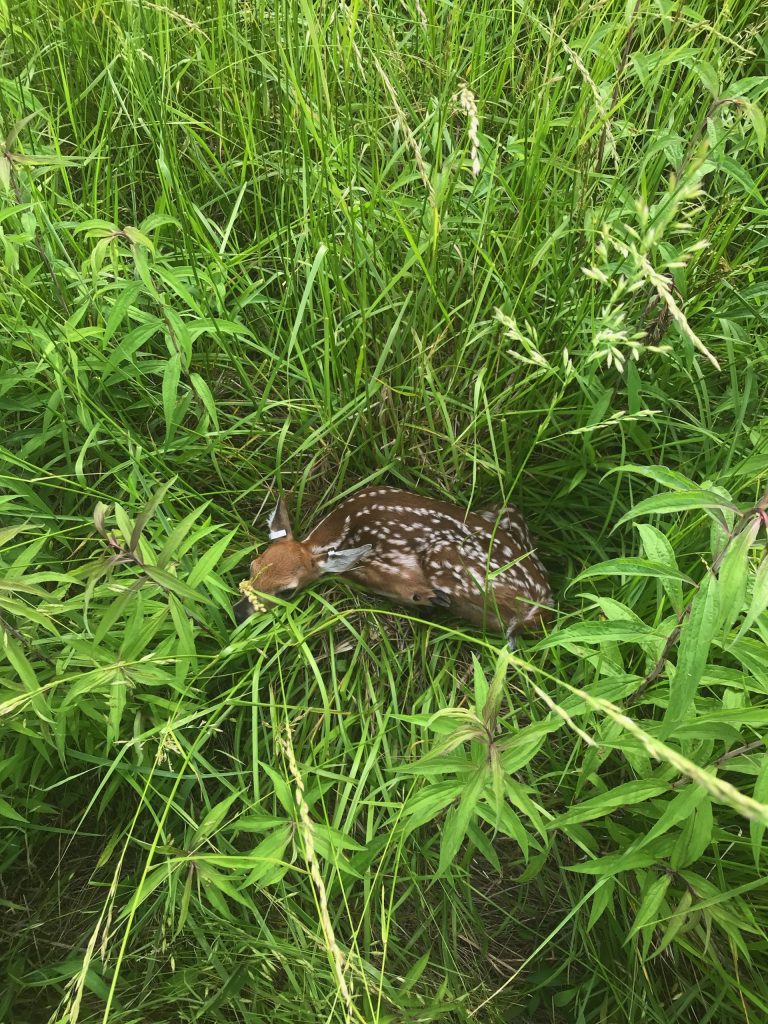Cue the Imperial March.
They will strike this weekend. Arriving by the thousands. A few scouts have already been deployed looking cute and helpless. But don’t be fooled. That cuteness is their secret weapon disarming the most hardened heart.
It is fawning season. And does across Pennsylvania are in labor right now. Yes, right now!
Anyone walking in the woods or across field of tall grass may stumble upon one of these invaders as they employ the time tested and outrageously successful strategy of hiding motionless. Waiting. Fooling predators and people alike with those spots and wobbly legs.
Although fawns can walk just hours after birth, they still need time to develop before using a ton of energy to move around. So for those the first few days of infiltration into enemy territory full of hostiles, fawns remain in stealth mode gathering intel.
As fawns develop, they start to follow the Mothership (pun intended) more and more. Surprisingly, we aren’t really sure when those fawns go from predominantly stealth mode to zipping around like TIE fighters with that Mothership. To the best of our knowledge, this may happen around 4 weeks old.
Why haven’t we unraveled the details of this yearly assault? While the invasion is strong in numbers, like stormtroopers, they are quite expendable. Many fawns die before reaching 4 weeks of age and it is really time consuming to find every collared fawn every single day to see how far it has moved. The resistance (i.e. crews) need days off, sometimes we are ill equipped (weekly truck repair saga), and those little invaders are REALLY good at selecting highly fortified bases (radio-telemetry signal bounce anyone?).
If you’ve followed the blog for awhile you might remember Jeannine, our resident Crazy Cat Lady. Using GPS devices meant to track domestic house cats, we tracked fawns to learn more about their movements! In a follow-up post, we showed the home range sizes of some of our fawns and their activity over time.
There have been lots of studies on fawns, but most don’t have access to GPS data for those fawns. Since we had both invader locations (i.e., fawns) and Mothership locations (i.e., the mothers), maybe Mothership home range size could represent the home range size of her tiny TIE fighters. Mothers spend about 50% of their time with their babies right after birth and restrict their movements. So if we take the doe’s 50% home range (the central area where she spends 50% of her time) – would that be the same as her fawn’s home range?
We looked at the home ranges of 4 fawns during the first week of life and the ranges of their Motherships during the same time. Four isn’t very many so the answer is…only sometimes does mom’s 50% home range match her baby’s overall movements. Surprise!
While fawns need mom for survival, they possess a certain amount of autonomy. They alone choose exactly where and when they move and where to hide. It’s the equivalent of them yelling “you’re not the boss of me!” to that Mothership.
What you see in the images below are the home ranges for our four fawns and their mothers. The fawn home range (95% home range) is in grey plotted with their positions.
The outermost solid line represents mom’s 95% home range. The inner solid black line is mom’s 50% home range (and the area in black is the part outside the fawns home range).

With such a small sample, there is much individual variability. Some fawn home ranges were spot on with their mom’s 50% range. But other fawns were ambitious and moved much farther!
How far you ask? Fawns A and C had home range size of 22 and 26 acres, respectively. While those with happy feet (Fawn B and D) had home ranges of 47 and 66 acres! I told you not to be fooled.
If you don’t have GPS location data for fawns, you cannot assume that 50% of the location data from mom represents the fawn’s home range.
Understanding fawn movement, and how they use the space around them, has implications for understanding what might influence fawn survival. Studies have shown that the habitat within a fawn’s home range or where they choose to bed down can influence its chances of being taken down by the resistance – bears, bobcats, coyotes, and people (Gulsby et al. 2017. Grovenburg et al. 2011) but what if we were looking at the wrong home ranges and bedding locations?
As technology develops, tracking the smallest spotted raider via GPS will become the norm. “Tiny” GPS collars are already being used to follow slightly larger interlopers like elk and moose calves. Soon that crazy cat lady will be promoted to General and be deploying kyber-sized tracking devices on our imperial invaders.
-Tess Gingery and Jeannine Fleegle
If you would like to receive email alerts of new blog posts, subscribe here.
And Follow us on Twitter @WTDresearch
